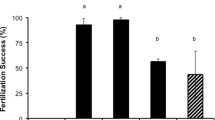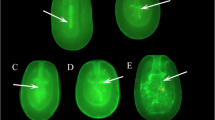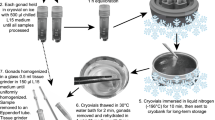Abstract
In this study, we evaluated the efficacy of sperm cryopreservation for use in larval-based propagation of Diploria labyrinthiformis and produced offspring that were maintained under controlled conditions. Gametes were collected from colonies in situ in July and August 2017 and 2018. The four largest colonies out of a total of nine appear to be senescent or produce low-quality sperm or eggs. Sperm was cryopreserved for comparison of the effects of storage time on sperm viability. We determined that cryopreserved sperm from D. labyrinthiformis is viable for at least 13 months for use in in vitro crosses, though their motility is reduced on average by 24% in comparison with fresh sperm. Using frozen sperm to fertilize freshly collected eggs led to successful fertilization, larval yields, settlement and post-settlement survival. In general, these were lower by 23%, 23%, 14% and 8%, respectively, when compared to controls fertilized with fresh sperm. Our results suggest that motility of fresh sperm is not a good indicator of the future fate of larvae because in some cases low motility led to successful settlement. We also found that not all crosses were successful, and that the direction of the cross significantly affects larval yields and settlement. Once symbionts were noticeable within the primary polyps the cryo-recruits were maintained in an ex situ nursery for observation and showed similar survival with respect to recruits produced with fresh sperm. Prior to the 2018 spawning event, Stony Coral Tissue Loss Disease (SCTLD) was detected in the studied colonies and by February 2020 seven of the nine colonies (78%) had succumbed to the disease. The sperm from these colonies was banked in a repository and since then has been used in genetic rescue projects for this species. Thus, we show that cryopreservation is a useful tool in actions designed to recover D. labyrinthiformis and can potentially be applied to other species of corals severely affected by SCTLD or in need of genetic rescue.




Similar content being viewed by others
References
Alvarado-Chaparro E, Garcia R, Acosta A (2004) Sexual reproduction of the reef-building coral Diploria labyrinthiformis (Scleractinia:Faviidae) in the Colombian Caribbean. Rev Biol Trop 52:859–868
Álvarez-Filip L, Estrada-Saldívar N, Pérez-Cervantes E, Molina-Hernández A, González-Barrios FJ (2019) A rapid spread of the stony coral tissue loss disease outbreak in the Mexican Caribbean. PeerJ 7:e8069
Barfield S, Aglyamova GV, Matz MV (2016) Evolutionary origins of germline segregation in Metazoa: evidence for a germ stem cell lineage in the coral Orbicella faveolata (Cnidaria, Anthozoa). Proc Biol Sci 83:20152128
Baums IB, Devlin-Duarte MK, Polato NR, Xu D, Giri S, Altman NS, Ruiz D, Parkinson JE, Boulay JN (2013) Genotypic variation influences reproductive success and thermal stress tolerance in the reef building coral Acropora palmata. Coral Reefs 32:703–717
Carlson SM, Cunningham CJ, Westley PAH (2014) Evolutionary rescue in a changing world. Trends Ecol Evol 29:521–530
Chamberland VF, Snowden S, Marhaver KL, Petersen D, Vermeij MJA (2017) The reproductive biology and early life ecology of a common Caribbean brain coral, Diploria labyrinthiformis (Scleractinia: Faviinae). Coral Reefs 36:83–94
Cirino L, Wen ZH, Hsieh K, Huang CL, Leong QL, Wang LH, Chen CS, Daly J, Tsai S, Lin C (2019) First instance of settlement by cryopreserved coral larvae in symbiotic association with dinoflagellates. Sci Rep 9:18851
Daly J, Zuchowicz N, Nuñez Lendo CI, Khosla K, Lager C, Henley EM, Bischof J, Kleinhans FW, Lin C, Peters EC, Hagedorn M (2018) Successful cryopreservation of coral larvae using vitrification and laser warming. Sci Rep 8:15714
Darling ES, Côté IM (2018) Seeking resilience in marine ecosystems. Science 359:986–987
Fadlallah YH (1983) Sexual reproduction, development and larval biology in scleractinian corals: a review. Coral Reefs 2:129–150
Feuillassier L, Masanet P, Romans P, Barthélémy D, Engelmann F (2015) Towards a vitrification-based cryopreservation protocol for the coral Pocillopora damicornis L.: tolerance of tissue balls to 4.5M cryoprotectant solutions. Cryobiology 71:224–235
Glassom D, Celleirs L, Schleyer MH (2006) Coral recruitment patterns at Sodwana Bay, South Africa. Coral Reefs 25:485–492
Häder D-P, Banaszak AT, Villafañe VE, Narvarte MA, González RA, Helbling EW (2020) Anthropogenic pollution of aquatic ecosystems: emerging problems with global implications. Sci Total Environ 713:136586
Hagedorn M, Spindler R (2014) The reality, use and potential for cryopreservation of coral reefs. Adv Exp Med Biol 753:317–329
Hagedorn M, Carter V (2016) Cryobiology: principles, species conservation and benefits for coral reefs. Reprod Fertil Dev 28:1049–1060
Hagedorn M, Spindler R, Daly J (2019) Cryopreservation as a tool for reef restoration. Adv Exp Med Biol 1200:489–505
Hagedorn M, Pana R, Cox EF, Hollingsworth L, Krupp D, Lewis TD, Leong JC, Mazur P, Rall WF, MacFarlane DR, Fahy G, Kleinhans FW (2006) Coral larvae conservation: physiology and reproduction. Cryobiology 52:33–47
Hagedorn M, Carter V, Martorana K, Paresa MK, Acker J, Baums IB, Borneman E, Brittsan M, Byers M, Henley M, Laterveer M, Leong J-A, McCarthy M, Meyers S, Nelson BD, Petersen D, Tiersch T, Cuevas Uribe R, Woods E, Wildt D (2012a) Preserving and using germplasm and dissociated embryonic cells for conserving Caribbean and Pacific coral. PLoS ONE 7:e33354
Hagedorn M, Van OppenCarter MJHV, Henley M, Abrego D, Puill-Stephan E, Negri A, Heyward A, MacFarlane D, Spindler R (2012b) First frozen repository for the great barrier reef coral created. Cryobiology 65:157–158
Hagedorn M, Farrell A, Carter VL (2013) Cryobiology of coral fragments. Cryobiology 66:17–23
Hagedorn M, Carter VL, Henley EM, van Oppen MJH, Hobbs R, Spindler RE (2017) Producing coral offspring with cryopreserved sperm: a tool for coral reef restoration. Sci Rep 7:14432
Hoegh-Guldberg O, Mumby PJ, Hooten AJ, Steneck RS, Greenfield P, Gomez E, Harvell CD, Sale PF, Edwards AJ, Caldeira K, Knowlton N, Eakin CM, Iglesias-Prieto R, Muthiga N, Bradbury RH, Dubi A, Hatziolos ME (2007) Coral reefs under rapid climate change and ocean acidification. Science 318:1737–1742
Hoffmann AA, Sgrò CM (2011) Climate change and evolutionary adaptation. Nature 470:479–485
Hughes TP, Baird AH, Bellwood DR, Card M, Connolly SR, Folke C, Grosberg R, Hoegh-Guldberg O, Jackson JBC, Kleypas J, Lough JM, Marshall P, Nyström M, Palumbi SR, Pandolfi JM, Rosen B, Roughgarden J (2003) Climate change, human impacts, and the resilience of coral reefs. Science 301:929–933
Lin C, Tsai S (2012) The effect of chilling and cryoprotectants on hard coral (Echinopora) oocytes during short-term low temperature preservation. Theriogenology 77:1257–1261
Lin C, Wang LH, Fan TY, Kuo FW (2012) Lipid content and composition during the oocyte development of two gorgonian coral species in relation to low temperature preservation. PLoS ONE 7:e38689
McField M, Kramer P, Giró Petersen A, Soto M, Drysdale I, Craig N, Rueda Flores M (2020) 2020 Mesoamerican Reef Report Card, p 36
Muller E, Vermeij MJA (2011) Day time spawning of a Caribbean coral. Coral Reefs 30:1147
Novak BJ, Fraser D, Maloney TH (2020) Transforming ocean conservation: applying the genetic rescue toolkit. Genes 11:209
Perry CT, Murphy GN, Kench PS, Smithers SG, Edinger EN, Steneck RS, Mumby PJ (2013) Caribbean-wide decline in carbonate production threatens coral reef growth. Nat Commun 4:1402
Precht WF, Gintert BE, Robbart ML, Fura R, van Woesik R (2016) Unprecedented disease-related coral mortality in Southeastern Florida. Sci Rep 6:31374
Shikina S, Chen CJ, Liou JY, Shao ZF, Chung YJ, Lee YH, Chang FC (2012) Germ cell development in the scleractinian coral Euphyllia ancora (Cnidaria, Anthozoa). PLoS ONE 7:e41569
Shikina S, Chung YJ, Wang HM, Chiu YL, Shao ZF, Lee YH, Chang CF (2015) Immunohistochemical localization of early germ cells in a stony coral, Euphyllia ancora: potential implications for a germline stem cell system in coral gametogenesis. Coral Reefs 34:639–653
Tan ES, Izumi R, Takeuchi Y, Isomura N, Takemura A (2020) Molecular approaches underlying the oogenic cycle of the scleractinian coral, Acroporatenuis. Sci Rep 10:9914
Tsai S, Yang V, Lin C (2016) Comparison of the cryo-tolerance of vitrified gorgonian oocytes. Sci Rep 6:23290
Tsai S, Yen W, Chavanich S, Viyakarn V, Lin C (2015) Development of cryopreservation techniques for gorgonian (Junceella juncea) oocytes through vitrification. PLoS ONE 10:e0123409
Van Oppen MJ, Gates RD (2006) Conservation genetics and the resilience of reef-building corals. Mol Ecol 15:3863–3883
Van Oppen MJH, Oliver JK, Putnam HM, Gates RD (2015) Building coral reef resilience through assisted evolution. Proc Natl Acad Sci USA 112:2307–2313
Van Tussenbroek BI, Hernández Arana HA, Rodríguez-Martínez RE, Espinoza-Avalos J, Canizales-Flores HM, González-Godoy CE, Barba-Santos MG, Vega-Zepeda A, Collado-Vides L (2017) Severe impacts of brown tides caused by Sargassum spp. on near-shore Caribbean seagrass communities. Mar Pollut Bull 122:272–281
Viyakarn V, Chavanich S, Chong G, Tsai S, Lin C (2018) Cryopreservation of sperm from the coral Acropora humilis. Cryobiology 80:130–138
Webster MS, Colton MA, Darling ES, Armstrong J, Pinsky ML, Knowlton N, Schindler DE (2017) Who should pick the winners of climate change? Trends Ecol Evol 32:167–173
Weil E, Vargas WL (2010) Comparative aspects of sexual reproduction in the Caribbean coral genus Diploria (Scleractinia: Faviidae). Mar Biol 157:413–426
Wyers SC, Barnes HS, Smith SR (1991) Spawning of hermatypic corals in Bermuda: a pilot study. Hydrobiologia 216(217):109–116
Zhang Y, Chiu Y, Chen C, Ho Y, Shinzato C, Shikina S, Chang C (2019) Discovery of a receptor guanylate cyclase expressed in the sperm flagella of stony corals. Sci Rep 9:14652
Acknowledgements
This project was funded by CONACYT project number 247765 to ATB and EM. We sincerely appreciate the technical assistance of C. Morera Román, F. Negrete Soto, E. Escalante Mancera, M.A. Gómez Reali and R. Tecalco Rentería and the opportunity to learn cryopreservation techniques from Dr. Mary Hagedorn. We also wish to thank Dr. Hagedorn and two anonymous reviewers whose suggestions helped to improve the manuscript. This work was undertaken with a permit authorized by the National Aquaculture and Fisheries Commission (CONAPESCA Nº. PPF/DGOPA-003/2017).
Author information
Authors and Affiliations
Corresponding authors
Ethics declarations
Conflict of interest
On behalf of all authors, the corresponding authors state that there is no conflict of interest.
Additional information
Publisher's Note
Springer Nature remains neutral with regard to jurisdictional claims in published maps and institutional affiliations.
Topic Editor Morgan S. Pratchett
Supplementary Information
Below is the link to the electronic supplementary material.
Rights and permissions
About this article
Cite this article
Grosso-Becerra, M.V., Mendoza-Quiroz, S., Maldonado, E. et al. Cryopreservation of sperm from the brain coral Diploria labyrinthiformis as a strategy to face the loss of corals in the Caribbean. Coral Reefs 40, 937–950 (2021). https://doi.org/10.1007/s00338-021-02098-7
Received:
Accepted:
Published:
Issue Date:
DOI: https://doi.org/10.1007/s00338-021-02098-7




